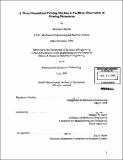| dc.contributor.advisor | Emanuel M. Sachs. | en_US |
| dc.contributor.author | Chijioke, Akobuije (Akobuije Douglas Eziani), 1974- | en_US |
| dc.contributor.other | Massachusetts Institute of Technology. Dept. of Mechanical Engineering. | en_US |
| dc.date.accessioned | 2005-08-22T22:47:45Z | |
| dc.date.available | 2005-08-22T22:47:45Z | |
| dc.date.copyright | 1998 | en_US |
| dc.date.issued | 1998 | en_US |
| dc.identifier.uri | http://hdl.handle.net/1721.1/9106 | |
| dc.description | Thesis (S.M.)--Massachusetts Institute of Technology, Dept. of Mechanical Engineering, 1998. | en_US |
| dc.description | Includes bibliographical references (leaf 156). | en_US |
| dc.description.abstract | The understanding of binder-powder interaction during the Three Dimensional Printing process is critical to improving the characteristics of parts produced by this process. The ability to observe the binder-powder interaction taking place could aid its investigation greatly. In the case of Three Dimensional Printing of fine ceramics, in which powderbeds are deposited as a liquid slurry before printing with a binder is done, the deposition of the powderbed itself is a part of the process the investigation of which could benefit from convenient automated image acquisition. Such observation requires flexible imaging capabilities of a nature that cannot easily be realized by using attachments to existing Three Dimensional Printing machines. This motivated the design and construction of a specialized imaging-oriented Three Dimensional Printing machine, the droplet impact observation station, which this thesis documents. The requirements of the machine are presented, the realized design and operation of the machined described, the results of initial tests of operation presented and areas for further work and improvement outlined. The droplet impact observation station constructed moves a carriage back and forth over a travel of up to 46.5 inches, at speeds of up to 2 mis with a total velocity ripple of approximately 0.007 mis. In the station's primary mode of operation, the moving carriage transports a powderbed, while the printhead remains stationary. Tests in which strobe illuminated images of crosshairs mounted on the moving carriage were obtained have demonstrated the ability to time a strobe flash to within +/- 1-2 microns. Strobe illuminated images of continuous-jetted droplets produced by the observation station have been obtained. | en_US |
| dc.description.statementofresponsibility | by Akobuije Chijioke. | en_US |
| dc.format.extent | 182 leaves | en_US |
| dc.format.extent | 10796872 bytes | |
| dc.format.extent | 10796631 bytes | |
| dc.format.mimetype | application/pdf | |
| dc.format.mimetype | application/pdf | |
| dc.language.iso | eng | en_US |
| dc.publisher | Massachusetts Institute of Technology | en_US |
| dc.rights | M.I.T. theses are protected by copyright. They may be viewed from this source for any purpose, but reproduction or distribution in any format is prohibited without written permission. See provided URL for inquiries about permission. | en_US |
| dc.rights.uri | http://dspace.mit.edu/handle/1721.1/7582 | |
| dc.subject | Mechanical Engineering. | en_US |
| dc.title | A three-dimensional printing machine to facilitate observation of printing phenomena | en_US |
| dc.title.alternative | 3-D printing machine to facilitate observation of printing phenomena | en_US |
| dc.type | Thesis | en_US |
| dc.description.degree | S.M. | en_US |
| dc.contributor.department | Massachusetts Institute of Technology. Department of Mechanical Engineering | |
| dc.identifier.oclc | 45041049 | en_US |
